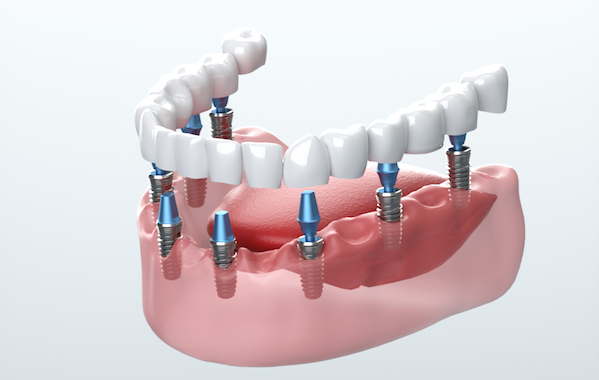Some Ideas on Dental Implants You Need To Know
Some Ideas on Dental Implants You Need To Know
Blog Article
Everything about Dental Implants
Table of ContentsSome Known Facts About Dental Implants.The Dental Implants IdeasDental Implants for BeginnersThe Definitive Guide for Dental Implants
are medical tools operatively implanted right into the jaw to recover a person's capability to eat or their appearance. They give support for artificial (phony) teeth, such as crowns, bridges, or dentures. When a tooth is shed as a result of injury or illness, an individual can experience difficulties such as rapid bone loss, defective speech, or modifications to eating patterns that lead to pain.
Structure of The Dental Implant System picking dental implants, talk to your oral copyright regarding the prospective benefits and threats, and whether you are a candidate for the treatment. Things to consider: Your total health and wellness is a crucial consider identifying whether you are a good candidate for oral implants, for how long it will take to heal, and how much time the implant may remain in area.
Cigarette smoking may affect the healing process and lower the long-term success of the dental implant. The healing process for the implant body might take numerous months or longer, during which time you usually have a short-term abutment in place of the tooth. the dental implant treatment: Thoroughly follow the dental health directions offered to you by your dental provider.
Some Of Dental Implants
Implant failing can result in the requirement for one more procedure to take care of or replace the dental implant system. Restores the capacity to eat Recovers aesthetic look Assists maintain the jawbone from shrinking due to bone loss Maintains the wellness of the bordering bone and periodontals Helps keep surrounding (close-by) teeth secure Enhances lifestyle Damage to surrounding all-natural teeth during implant positioning Injury to the surrounding cells during surgical treatment, such as sinus opening Injury throughout surgical procedure (as an example, crack of bordering jawbone) Inadequate function, such as feeling like the teeth do not attack with each other typically A feeling that the tooth is loosened or twisting in place arising from a joint screw loosening Implant body failing (looseness of the dental implant body) because of systemic infection, which may be more most likely in individuals with unrestrained diabetics issues due to local infection in bone and gum tissues supporting the implant body as a result of postponed healing, which might be a lot more likely in patients that smoke Difficulty cleansing the periodontals around the dental implant, leading to poor dental hygiene Untreated gum disease Post-surgical numbness because of nerve impingement or damage Always notify wellness care suppliers and imaging specialists that you have dental implants prior to any magnetic resonance imaging (MRI) or x-ray treatments.
FDA is not conscious of any damaging events reported for MRI or x-ray treatments with dental implants. Dental implants systems are typically constructed from materials that follow global consensus criteria of the International Company for Standardization (ISO) or ASTM International. These standards have information of what makes a risk-free product.
Dental implant systems are evaluated according to international consensus standards. Biocompatibility screening, to reveal that physical call with the gadget does not trigger problems like irritation or allergic response, is part of the analysis that aids ensure the products in the oral implant system are risk-free and do not trigger unfavorable impacts when dental implanted in individuals.

The Best Guide To Dental Implants
Some individuals are not qualified for oral implant surgical procedure. It is for oral cosmetic surgeons to operate on people with: acute illnessuncontrollable metabolic diseasebone or soft tissue illness or infectionIf these problems are solved, an individual can have the surgical procedure. Dental Implants. In, dental cosmetic surgeons avoid operating people with: If people with any of the above go through oral implant surgical procedure, there is a higher danger of the dental implant falling short
Some people have a jawbone irregularity that protects against enough bone for an implant from establishing. In such instances, a surgeon may need to carry my response out a ridge modification. This involves raising the gum to expose the area you could look here of deformed bone. The specialist will after that utilize a bone or bone replacement to repair and accumulate the location.
Oral dental implant surgery is a customized procedure. It's not the same for every person. The complying with offers a general review of what you can anticipate your dental practitioner, oral surgeon, periodontist or prosthodontist to do: Put the dental implant surgically. Offer you time to heal. Connect the post and last crown, bridge or denture.
Next off, your cosmetic surgeon will thoroughly put the dental implant right into your jaw. Your surgeon will certainly rearrange your gums and shut the incision with stitches (Dental Implants). If your dental implant is near the front of your mouth, your dental expert will make a short-term tooth for you to put on till you heal. This way, you won't have a gap in your smile while you recover.
The Best Strategy To Use For Dental Implants
Your supplier can tell you what to anticipate in your situation. During the healing phase, your jawbone must fuse to the dental implant. This procedure, called osseointegration, is important for stability and long-lasting success. This process can take anywhere from 3 to 9 months. Sometimes, it may take longer.
Once your dental implant heals, your dentist can attach the joint (tiny connector message) and your last repair (crown, bridge or denture). This normally takes concerning one hour to complete and may need a second minor surgical treatment. You should not really feel any type of discomfort during your dental implant treatment due to the this fact that your supplier will certainly utilize drug to numb your gum tissues.
Report this page